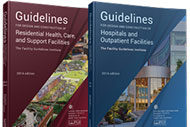HHS sets new targets to eliminate HAIs
The Department of Health & Human Services has announced new targets for its National Action Plan to Prevent Health Care-Associated Infections: Road Map to Elimination. The new goals replaced previous targets established in 2013. The action plan addresses eight measures, including reducing facility-onset Clostridium difficile and methicillin-resistant Staphylococcus aureus infections; HHS wants to reduce these measures by 30 percent and 50 percent, respectively, by 2020. The plan outlines three phases and addresses acute care hospitals, ambulatory surgical centers and long-term care facilities.
Joint Commission starts surveying to 2012 codes
Although Joint Commission-accredited facilities are not required to comply with the National Fire Protection Association’s 2012 NFPA 101 and NFPA 99 codes until Jan. 9, the organization says it already has begun surveying ambulatory care, behavioral health care, critical access hospital, hospital, home care and nursing care center programs according to the recently adopted codes. The Joint Commission adopted the codes in concert with the Centers for Medicare & Medicaid Services, which adopted the codes in May. The Joint Commission also revised several requirements in its Environment of Care and Life Safety chapters to stay consistent with the NFPA codes.
WHO infection guidelines address environment
The World Health Organization has updated its Global Guidelines on the Prevention of Surgical Site Infection. The 186-page document includes a section on the role the built environment can play in this effort. “For many years, environmental contamination was considered to be less important than many other factors in contributing to health care-associated infections,” WHO officials state. “However, recent evidence shows that a contaminated health care environment plays a significant role in the transmission of microorganisms.”
CMS proposes requirements for some dialysis facilities
The Centers for Medicare & Medicaid Services announced a proposed rule to update Medicare fire protection guidelines for certain dialysis facilities to ensure that patients are protected from fire while receiving treatment in those facilities. The rule adopts updated provisions of the National Fire Protection Association’s (NFPA’s) 2012 edition of the Life Safety Code, as well as provisions of the NFPA’s 2012 edition of the Health Care Facilities Code. The proposed rule addresses construction, protection and operational features of dialysis facilities to provide safety from fire and smoke to Medicare beneficiaries.
Joint Commission and ASHE release hazmat resource
The American Society for Healthcare Engineering in partnership with the Joint Commission has posted new Focus on Compliance resources to help health care facilities comply with Joint Commission standards on handling hazardous materials and waste. Areas that are commonly listed as noncompliant include eye washes not available or properly accessible, installed, tested and inspected; improper storage of protective lead aprons or covers; and staff use of chemicals without proper personal protective equipment.
AHE launches infection prevention certification for ES
The Association for the Healthcare Environment developed a new certification called the Certificate of Mastery in Infection Prevention for Environmental Services Professionals. The intensive 20-hour certificate program provides environmental services leaders and professionals with requisite knowledge to meet the Centers for Medicare & Medicaid Services’ requirement for trained professionals in infection prevention and control specific to the clinical environment of care. The certification covers microbiology and epidemiology; patient and health care worker safety; surveillance, risk assessment and outbreaks; antimicrobial stewardship; evidence-based cleaning practices and environmental monitoring; and preventing infection during construction and emergencies.





